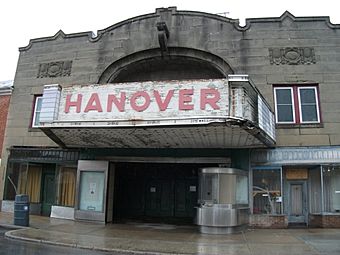Hanover Historic District facts for kids
Quick facts for kids |
|
|
Hanover Historic District
|
|

Hanover Theater, March 2011
|
|
| Location | Roughly bounded by Elm Ave., Broadway, Eisenhower Dr., Hollywood Ave., and Hanover borough boundary line, Hanover, Pennsylvania |
|---|---|
| Area | 885 acres (358 ha) |
| Built | 1852 |
| Architect | Dempwolf, John A. & Reinhardt |
| Architectural style | Colonial Revival, Queen Anne, PA German vernacular |
| NRHP reference No. | 96001552 |
| Added to NRHP | January 2, 1997 |
The Hanover Historic District is a special area in Hanover, Pennsylvania, York County, Pennsylvania. It's like a big outdoor museum! This district is a "historic district," which means it's a place with many old and important buildings, sites, and objects. These places show us what life was like long ago.
The district covers a large part of Hanover, including the main shopping area and nearby homes. It has over 2,600 buildings that help tell the story of the town. This important district was added to the National Register of Historic Places in 1997.
Contents
History of Hanover: A Town's Journey Through Time
Hanover started as a piece of land given by Lord Baltimore in 1727. This land was first called Digges Choice. Later, in 1730, its name changed to the Conewago Settlement. Many Catholic families from Pennsylvania and Maryland moved here.
How Hanover Began: Richard McAllister's Vision
In 1745, a man named Richard McAllister bought the land where Hanover now stands. It was a thick forest back then! He cleared some of the trees and built a log home, a store, and a tavern. This spot is now the corner of Baltimore and Middle Streets. McAllister officially founded the town of Hanover in 1763. The town's name might have come from Hannover, Germany. Michael Tanner, who helped plan York County, suggested it.
Famous Visitors: Thomas Jefferson's Stops
On April 12, 1776, Thomas Jefferson visited Hanover. He was on his way from his home in Virginia to Philadelphia. In Philadelphia, he would help write the Declaration of Independence. Jefferson stayed at the Sign of the Horse inn on Frederick Street. He also stopped there again on September 5, 1776, on his way back home. At that time, Hanover had about 500 homes, mostly made of logs.
Hanover's Role in Wars and Growth
Hanover played a part in the War of 1812. Two groups of soldiers from Hanover helped stop British troops. This happened in 1814 during the Battle of North Point.
The town grew even more with the arrival of railroads. The Hanover Branch Railroad was built in 1852. Then, the Gettysburg Railroad opened in 1858, connecting Hanover to Gettysburg. In 1876, the Hanover and York Railroad linked the town to York. These railroads made travel and trade much easier.
On June 30, 1863, Hanover saw a small but important battle. It was the last fight between Union and Confederate armies. This happened just before the big three-day Battle of Gettysburg during the American Civil War.
Creating the Historic District: Protecting Hanover's Past
The Hanover Historic District covers about 885 acres. It includes the oldest parts of the town. Five main roads meet in the center of the district. This road layout has been the same since Hanover began. The district's borders were chosen to include the most historic buildings. This helps protect the town's rich history. This historic district was officially listed on the National Register of Historic Places in 1997.
Hanover's Architectural Styles: A Look at Old Buildings
Most buildings in the Hanover Historic District were built between 1870 and 1946. You can see different styles of architecture here. Some popular styles include Colonial Revival, Queen Anne, and Pennsylvania German vernacular. These buildings are made of wood frames or brick.
Notable Buildings and Structures in the District
Many buildings are considered "contributing." This means they add to the historic importance of the district. Some examples include:
- The Forney House (built 1905)
- Evangelical Brethren Church Rectory (around 1930)
- Hanover Shoe Store (around 1930)
- Sheppard and Myers Building (around 1890)
- McCalister Inn (around 1925)
- Peoples Bank building (1901)
- Hanover Broad Silk Works (around 1910)
- Myers and Sheppard Residence (1912-1913)
- Emmanuel United Church of Christ (1899)
- Union Station (1892)
- Bank of Hanover (1906)
- Hanover Public Library (1910)
There are also some special structures. These include two natural gas pumping stations (around 1940) and a railroad freight car (1922). Some buildings in the district are so important they are listed separately. These are the Eichelberger High School, the George Nace (Neas) House (around 1783), and the U.S. Post Office.



